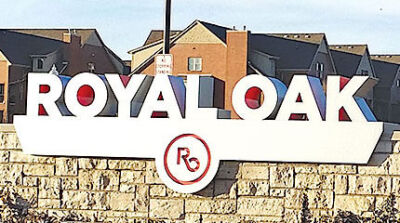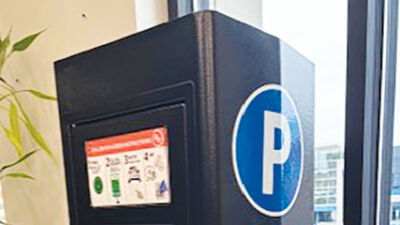‘From Wilderness to the City of Royal Oak’
ROYAL OAK — Royal Oak became a city on Nov. 8, 1921, but before that it was a plot of land, a township and then a village.
The creation of the city was due to many factors that will be talked about in the program “From Wilderness to the City of Royal Oak,” by Bob Muller, at 7 p.m. Jan. 12 at the Royal Oak Historical Society’s museum, 1411 W. Webster Road.
In this presentation, Muller will explain how Royal Oak has changed since 1817, when Royal Oak was merely a plot of land being surveyed for purchase.
Since then, the land was filled with farms, slowly turning into the village of Royal Oak, and eventually into the city of Royal Oak.
The event is limited to 50 people. Tickets for the event cost $15 and can either be purchased at the door or at royaloakhistoricalsociety.com/shop/ols/products/growth-of-royal-oak.
City Commission approves vehicle purchases
ROYAL OAK — The City Commission unanimously approved the purchase of five new vehicles and three pieces of equipment for the city’s fleet last month.
During the Dec. 18 meeting, Aaron Filipski, director of public services and recreation, requested approval to purchase these vehicles and equipment for the upcoming year.
Each year, as part of the capital improvement plan and budget process, the department of Public Services will develop a six-year outlook on recommended vehicles and equipment that should be replaced, according to Filipski.
In previous years, items that were proposed to be bought would be presented to the board one by one, according to Filipski.
The items approved included a 2024 Ford F-250 to replace a 2015 concrete crew truck; a 2024 Ford F-450 to replace a 2008 model that serves as a miniature dump truck; additional equipment for that new mini dump truck; a 2024 Ford F-350 super cab to replace a service truck from 2001; a 2024 Ford Edge SEL to replace a 2015 Ford Taurus as a multi-use vehicle in the Police Department; a 2023 Vermeer SC552 stump grinder; a 2024 ride-on sweeper; and a vacuum truck built on a new Freightliner chassis.
The total cost of vehicles, minus the vacuum truck, comes out to $336,449.84. The city anticipates getting $16,000 in trade for its current stump grinder. The vacuum truck has a price of $574,803.74; it was originally in the plans for the 2024-25 fiscal year, but the truck has a one- to two-year lead time for building and delivery, so the city decided to approve it now. The current vacuum truck will be sold for the best return once the new truck is delivered.
Electric vehicles were also mentioned that night; Filipski explained that this year would not allow for the purchase of electric vehicles, but they are planning on implementing those in the future.
New stop signs approved for ‘T’ intersections of Nahma Avenue, in Clawson
CLAWSON — Council members unanimously agreed to install stop signs at three “T” intersection on Nahma Avenue at the Dec. 19 City Council meeting.
One stop sign will be placed on Nahma Avenue and Charlevoix Street, one at Nahma Avenue and West Tacoma Street, and the third at Nahma Avenue and Madison Avenue.
A study conducted by the Clawson Traffic and Safety Board and the Transportation Improvement Association determined that placing stop signs at each of these intersections will prevent future crashes and help the flow of traffic, according to the information given in the agenda packet for the Dec. 19 meeting.
Since the reports did not show any crash history, Mayor Pro Tem Susan Moffitt questioned the need for these stop signs, and why exactly they were being installed.
In response, Director of Engineering Chuck Keller said that they do look at crash history, but one of the major aspects they look at is sight distance at the intersection.
“The issues of fences, house corners, trees, shrubs, have limited the sight distance to less than 10 miles per hour as you approach the intersection,” he said.
Voting precincts to change from 24 to 18 in Royal Oak
ROYAL OAK — Currently Royal Oak has 22,113 voters on the permanent absentee ballot list, and a voter population of 50,138, according to a proposal from the Dec. 18 City Commission meeting.
The passage of state proposal 22-2 last year made it possible for early voting for all future elections. With this change, voters now have several options on how to vote.
They can cast their ballots in person during the nine-day early voting period, vote by absentee, or vote in person at their precincts on Election Day.
According to the document, bills to expand precinct sizes from 2,999 voters to 4,999 voters were recently signed into state law.
Royal Oak has 24 precincts, but because of this change in the law, and the ability to increase voters per precinct, it was proposed on Dec. 18 to lower that number to 18 precincts and have more voters per precinct.
The proposal, written by City Clerk Melanie Halas, said that because of the many different ways voters can vote, it makes sense to raise the number of voters per precinct and lower the number of precincts.
According to the document, the election commission met on Dec. 11 and unanimously approved the precinct consolidation plan.
Following these changes, the Clerk’s Office will be contacting voters in the changed precinct sections before the next election, which takes place on Feb. 27.
Commissioner Sharlan Douglas said that this will not only be a good change for voting, but will also solve the problem of recruiting staff to work at the precincts.
Mayor Michael Fournier agreed and felt that fewer precincts would be safer.
“Our Police Department being stretched over multiple precincts can be a challenge,” he said.
Because of the fewer number of precincts, police will be more readily available, he said.
The commission unanimously agreed to change the 24 precinct locations to 18.
City Commission approves employment agreement with interim city manager
ROYAL OAK — An employment agreement regarding Todd Fenton’s role as interim city manager proposed to the Royal Oak City Commission was unanimously approved at the Dec. 18 meeting.
Within the document it states that the city agrees to pay Fenton a monthly stipend of $1,250 in addition to his current base salary for added duties as interim city manager.
The agreement had a suggested start date of Dec. 1, due to that being the beginning of his duties as interim city manager following the resignation of Paul Brake.
It was agreed that the search for a new city manager will take approximately four months, and unless there is a written letter of resignation or a new city manager is found, Fenton will remain interim city manager.
If Fenton does not take on the full role of city manager, he will resume his previous employment as deputy city manager.
 Publication select ▼
Publication select ▼


























